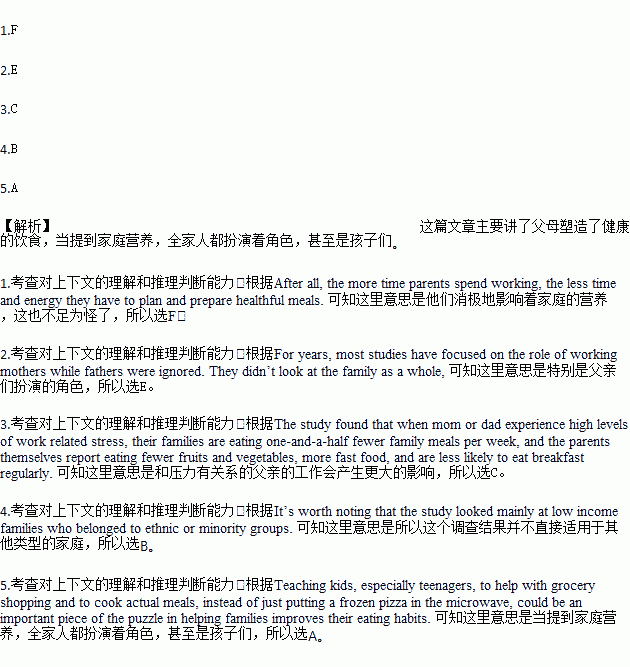题目内容
Parents Model Healthy Eating
It should come as no surprise that the more stressed parents are not work, the greater the burden on their family is. 1.After all, the more time parents spend working, the less time and energy they have to plan and prepare healthful meals.
For years, most studies have focused on the role of working mothers while fathers were ignored. They didn’t look at the family as a whole, 2., adds a new wrinkle to the relationship between work stress and family nutrition.
Moms’ work related stress is still a central factor in how well families eat because they typically do most of the food shopping and cooking.3.The study found that when mom or dad experience high levels of work related stress, their families are eating one-and-a-half fewer family meals per week, and the parents themselves report eating fewer fruits and vegetables, more fast food, and are less likely to eat breakfast regularly.
It’s worth noting that the study looked mainly at low income families who belonged to ethnic or minority groups. 4. But the implications are wide ranging.
5.Teaching kids, especially teenagers, to help with grocery shopping and to cook actual meals, instead of just putting a frozen pizza in the microwave, could be an important piece of the puzzle in helping families improves their eating habits.
A. When it comes to family nutrition, the entire family plays a role even kids.
B. so the findings don’t necessarily apply directly to other types of families
C. But dad’s work related stress has a large impact, too.
D. Yet, the kids’ stress may influence the families’ nutrition, too
E. and at the role of fathers in particular
F. It’s also probably not a surprise that his can negatively affect a family’s nutrition
G. It is parents who give their kids a good model to develop a good eating habit.
Monday | ||
8 —10 a. m. | TECHNOLOGY Information Technology (IT)—Using the Internet In this lesson, students learn how to surf the internet safely and effectively. There will also be information about using different search engines. | |
10:00 a. m. | DRAMA Students learn the play that the teacher gave before class. During this lesson, students will have the chance to act out roles with other students. | |
11:00 a. m. | PAINTING WITH WATERCOLOURS For most of this term, students learn how to use watercolours properly to make pictures. If the weather is good, the lesson may take place outdoors. | |
2 — 4 p. m. | SPORTS Students learn about the skills in a certain sport by watching video to see real action from past games. And then, students will play a short match lasting 45 minutes. This week, the sports are football (for boys) and tennis (for girls). | |
| HOMEWORK IT—the teacher will give students websites to look up at home. (about 20 minutes) Drama –students have to learn a part for the next lesson (about 40 minutes). | |
1.At _______, students are having a painting lesson.
A. 11:35 a. m. B. 4:30 p. m.
C. 10:30 a. m. D. 2:15 p. m.
2.Students should prepare a new part of _______ ahead of time as their homework.
A. Technology B. Painting
C. Sports D. Drama
3.The information in the table is mainly for students to _______.
A. choose teachers B. do their homework
C. take classes D. organize hobby groups


